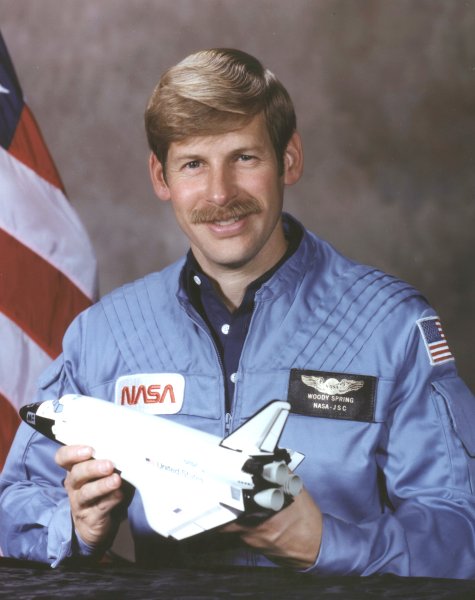- Sherwood C. Spring
Infobox Astronaut
name =Sherwood Clark "Woody" Spring
type =Astronaut
nationality =American
date_birth =birth date and age|1944|9|3
place_birth =Hartford, Connecticut
occupation =Test Pilot
rank =Colonel , U.S.
selection =1980 NASA Group
time =6d 21h 04m
mission =STS-61-B
insignia =Sherwood Clark "Woody" Spring is a retired
United States Army Colonel and formerNASA astronaut . He is the father of United States OlympianJustin Spring .Personal data
Born September 3, 1944, in Hartford, Connecticut, but considers Harmony, Rhode Island, to be his hometown. He was active in the
Boy Scouts of America where he achieved its second highest rank,Life Scout . Married to the former Collette (Debbie) Cooper, two children Sarah (Medical School at Georgetown University) and Justin (Men's National Gymnastics Team and Olympic athlete). He enjoys flying, scuba diving, white-water river running, skiing, and carpentry.Education
Graduated from
Ponaganset High School (North Scituate, Rhode Island) in 1963; received a bachelor of science degree in General Engineering from theUnited States Military Academy in 1967 and a master of science degree in Aerospace Engineering from theUniversity of Arizona in 1974. Graduated from theUnited States Navy Test Pilot School in 1976 and the Defense Systems Management College in 1989.Organizations
Member of the
Society of Experimental Test Pilots ,United States Army Association , Association of Space Explorers (ASE), and a lifetime member of theAssociation of Graduates of the United States Military Academy .pecial honors
Defense Distinguished Service Medal , Distinguished Flying Cross, 2 Bronze Stars, 1 Meritorious Service Medal, 3Army Commendation Medal s, 9Air Medal s, aVietnam Cross of Gallantry with Palm,National Defense Service Medal ,Vietnam Service Medal s, andNASA Space Flight Medal . Recipient, in 1986, of two honorary doctorate degrees; Doctor of Science, and Doctor of Humane Letters.Experience
After graduation from West Point in 1967, Spring served two tours of duty in Vietnam. The first was from 1968 to 1969 with the
101st Airborne Division . The second tour, 1970-1971, came immediately after flight school and was served as ahelicopter pilot with the1st Cavalry Division (United States) . Upon return, he received fixed wing training en route to a master's degree program with the University of Arizona in 1974. After a short tour atEdwards Air Force Base ,California , as a flight test engineer, he attended the Navy Test Pilot School atPatuxent River, Maryland . He then returned to the Army's Flight Test Facility at Edwards AFB to complete 4 years as an experimental test pilot.He has military and civilian experience in 25 types of airplanes and helicopters and has logged more than 3,500 hours flying time--including over 1,500
hour s in jet aircraft.NASA experience
Spring was selected as an astronaut in May 1980. His technical assignments have included software verification at the
Shuttle Avionics Integration Laboratory andFlight Simulation Laboratory ; vehicle and satellite integration at theKennedy Space Center ,Florida , forSTS-5 , 6, 7, 8, and 9; Astronaut Office EVA (Extra Vehicular Activity) expert; and Space Station construction, EVA maintenance, and design. Spring served as a mission specialist on STS-61B which flewNovember 26 ,1985 throughDecember 3 ,1985 . During that mission he was responsible for launching three communications satellites and performed two EVA's. During the EVA's, which totaled more than 12 hours, Spring investigated Space Station construction techniques, large structure manipulation while on the end of the remote arm, and a time and motion study for comparison between Earth training and Space performance, with the EASE/ACCESS experiment. With the completion ofSTS-61-B , he has logged a total of 165 hours in space, including over 12 hours of EVA. After the Challenger accident, Spring participated in the Kennedy Space Center Tiger Team for accident investigation, then led the Astronaut Office EVA (Extra Vehicle Activity) program until 1988.Following his retirement form NASA in August 1988, Colonel Spring spent the next five years directing the Army Space Program Office in
Washington, D.C . He retired from the Army in July 1994, and is now a contractor working on Defense and Intelligence programs in the Washington DC area.ee also
References
* http://www.jsc.nasa.gov/Bios/htmlbios/spring-sc.html
Wikimedia Foundation. 2010.
